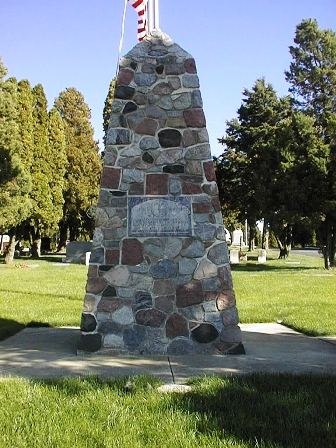610 Dundee Avenue, between Hillside and Coolidge Avenues, Barrington. Barrington Township, Cook County, Illinois. It is open for burials. The Barrington Area Library has a grave map with names of those who purchased the lots.
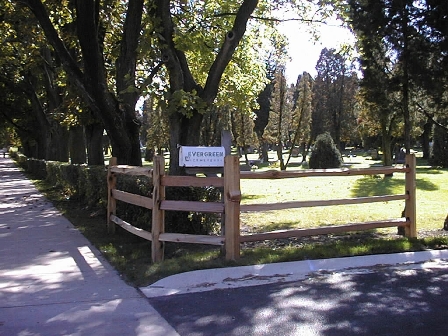
Transcription
Transcription, Arnett C. Lines, date unknown
Introduction
Compiled by Julia Rock, Barrington Historical Society, May, 1988.
This cemetery, comprising 32 acres west to the E.J. & E. tracks was organized during the period 1850-1855. The oldest part of the cemetery is the south section. The Womans Relief Corps #85, a Civil War Veterans Auxiliary, raised money for the Civil War monument which is the focal point of the cemetery. The inscription on it reads as follows:
"In Memory of our Civil War Heroes
1861-1865
Erected by Womans Relief Corps #85"
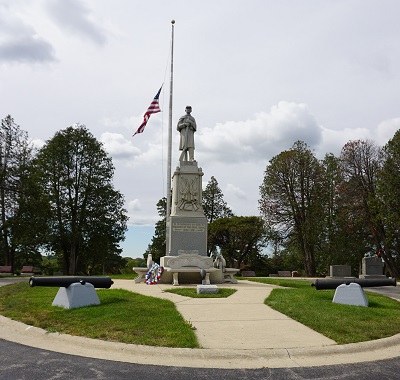
When the monument was installed and dedicated in September, 1906, three Civil War cannons were placed along the front of the monument's circular plot of ground, with an extra large cannon in front of the monument. These were put in cement and iron strapped in place. On the north and south sides of the circle, large triangles of Civil War cannon balls were set in cement and welded together. A smaller Civil War cannon is located in back of the monument. In spite of firm fastening of these items, theft has been a problem over the years. The extra large cannon in front of the monument and the cannon balls were stolen, never to be found. The two smaller cannons were stolen, but retrieved. One was found on Lake Zurich Road and the other on Otis Road. There is one remaining cannon and some cannon balls, which dare not be put out, and are stored in the cemetery garage.
There is a cement marker on the ground in front of the monument with this inscription:
"Union Cannon used in Civil War, 1861-1865, captured, spiked, and recaptured at Chicamauga, Sept. 1863"
Directly west of the Civil War Monument and down a slope is the cemetery section purchased and set up for veterans' graves by American Legion Post 158 of Barrington after World War I which is marked by a pylon dedicated in 1955. One section of this grave plot is set aside for veterans without funds, with an honorable discharge, and a Barrington address. These veterans can be buried there at no cost. another area contains plots for veterans and their wives.
A cannon is located along the southwest side of the pylon which was manufactured by the Japanese in 1911 and used by their army against General Douglas MacArthur's Army in the Philippines where it was captured by the United States Army, circa 1912. It was received by the American Legion Post #158 from the United States government as a replacement for a World War I cannon that the American Legion Post had placed at the flagpole in the center of the village of Barrington after World War I. This cannon was donated to the World War II scrap drive. Upon receiving it, the U.S. Government promised to replace it after World War II which it did in the mid 1950s. The American Legion Post then placed it in Evergreen Cemetery in 1976. An interesting point to see is the Japanese inscription of the make, model, and date on the top of the cannon about halfway between the back and the front.
The south side of the pylon is inscribed:
U.S. Army
To those gallant members of the Army who served
So valiantly to promote freedom and eternal peace
This veterans memorial section sponsored by Barrington Post 158 the American Legion and the Citizens of this community in honor of the men and women who have served in the Armed forces of The United States of America
Dedicated May 30, 1955
On the west side of the pylon is a dedication inscription to the U.S. Air Force. The Marines and Coast Guard are remembered on the north side and the Navy is honored on the east side of the pylon.
In front of the cannon is a tablet cemented in the ground which reads:
Dedicated July 3, 1976
Barrington Post No. 158
American Legion
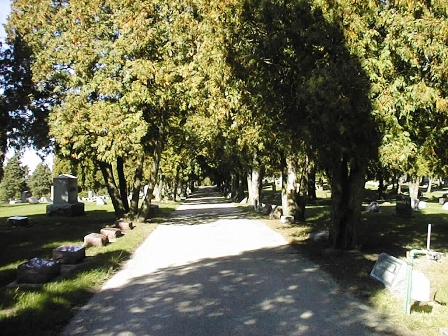
Evergreen Cemetery (From: A History of Barrington, Illinois by Arnett C. Lines)
Evergreen Cemetery was organized in 1867 under the Illinois law of 1855 as a private cemetery. Although there are several kinds of cemetery associations allowed by the law, this one was owned and used by the lot owners for non profit. The center of the organizing force seems to have been George Ela, M.B. McIntosh and William G. Waterman. A group of citizens was invited to meet March 14, 1867, in the depot, and Trustees elected were L.H. Bute, M.B. McIntosh, Henry Crabtree, Gilbert A. Applebee A.A. Cowdery. At the next meeting on the twenty-first of that same month, M.B. McIntosh was elected President and A.A. Cowdery was Secretary. The five trustees contributed fifty cents apiece to buy a secretary book and several accessories. A committee of these trustees looking for a suitable plot of ground reported a piece of five acres, now a part of the older section at the south end of the cemetery, was available. The committee procured the same from the owner Henry Clausen and gave their private note at 10% in payment.
The plot was designed by a Mr. J.W. Powers in 1868. It was surveyed for blocks and lots by L.D. Kendall, surveyor of Kane County, which survey was confirmed by Alex Woolcott who was the Cook County Surveyor.
A charter was granted them in 1869 and those who were charter lot owners prior to that September 11th, 1869 were: George Ela, Benjamin Chase, Philetus Beverly, Mrs. D. Winter, C. Hastings, M.B. McIntosh, A.A. Cowdery, George W. Jillison, Mrs C. Boyes, James Creet, Sr., Willard Stevens, G.A. Applebee and A.S. Henderson. A few of those lot owners soon after were: William G. Waterman, James Holden, Mrs. S. Abbott, E.H. Nelson, I.W. Clark, C.T. Blair, William Howarth, S.A. Randall, Uriah L. Burlingham, William Spunner, Chester Hutchinson and S.C. Jaynes.
When the original five acres was bought, it was plowed and planted to oats. As the lots were sold off, the balance offered a considerable amount of hay which brought in some revenue. Your author saw his brother, R.M. Lines, when we were both barefooted, kill a poisonous spotted adder with a pitch fork while he was turning hay for grandfather McIntosh.
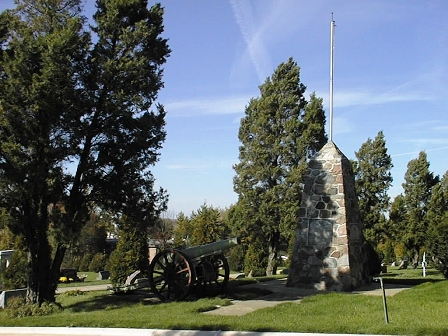
The Veterans Memorial Section
The Veterans Memorial Section in Evergreen Cemetery as a burial place for those without relatives or ability to provide for their own grave, was conceived by Roy Willmering, Graves Registrar Appointed by the Government, and Legion Service Officer, in the Spring of 1954, and was perfected by hard work and solicitation. A plot 40 x 82 feet, donated by Evergreen Cemetery Association, was designed for fifty-three graves, including the nine who were already buried there west of the Soldiers and Sailors Monument of 1906. A massive monument of split-faced native granite stone was erected in the center of the lot. The design and layout were the work of our very active Roy Willmering to whom much credit is due beyond the original idea for directing the project to its completion. This Veterans Memorial Section was dedicated by an impressive Memorial Day service, May 30, 1955.
Mr. Willmering informs us that, at the time of dedication of this Memorial Plot, there were buried in and about Barrington, 160 war veterans -- 10 of the War of 1812, 2 of the Indian Wars, 79 of the Civil War, 1 of the Spanish-American War, 45 of World War 1, 11 of World War II, and 2 of the Korean War. 118 of these graves are in Evergreen Cemetery. The others are in St. Paul, White, Smith, and Barrington Center.
